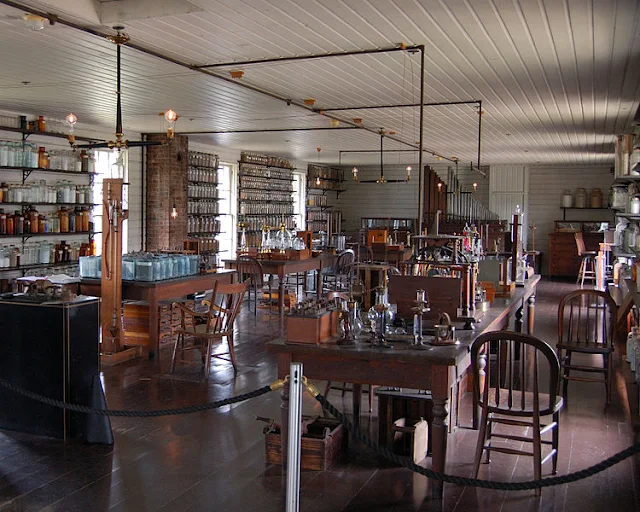 |
| Queen Victoria and Prince Albert stand with their children around a Christmas tree lit with candles. |
Lighting The Christmas Tree in England
The illuminated Christmas tree became established in the United Kingdom during Queen Victoria's
reign, and through emigration spread to North America and Australia. In
her journal for Christmas Eve 1832, the delighted 13-year-old princess
wrote, "After dinner.. we then went into the drawing-room near the
dining-room. There were two large round tables on which were placed two trees hung with lights and sugar ornaments. All the presents being placed round the trees".
Until the availability of inexpensive electrical power in the early
twentieth century, miniature candles were commonly (and in some cultures
still are) used.
In the United Kingdom, electrically powered Christmas lights are generally known as fairy lights. In 1881, the Savoy Theater, London was the first building in the world to be lit entirely by electricity. Sir Joseph Swan, inventor of the incandescent light bulb, supplied about 1,200 Swan incandescent lamps, and a year later, the Savoy owner Richard D'Oyly Carte
equipped the principal fairies with miniature lighting supplied by the
Swan United Electric Lamp Company, for the opening night of the Gilbert and Sullivan opera Iolanthe on 25 November 1882. The term fairy lights for a string of electrically powered Christmas lights has been in common usage in the UK ever since.
 |
| Real candles lighted on a Christmas tree, 1900. |
Lighting The Christmas Tree in America
Edward Hibberd Johnson was an inventor and business associate of American inventor Thomas Alva Edison. He was involved in many of Edison's projects, and was a partner in an early organization which evolved into the General Electric Company, one of the largest Fortune 500 companies in the United States. When Johnson was Vice President of the Edison Electric Light Company, a predecessor of Con Edison, he created the first known electrically illuminated Christmas tree at his home in New York City in 1882. Edward H. Johnson became the Father of Electric Christmas Tree Lights i.e., strand lights.
The first known electrically illuminated Christmas tree was the creation of Edward H. Johnson. While he was Vice-President of the Edison Electric Light Company,
he had Christmas tree bulbs especially made for him. He proudly
displayed his Christmas tree — hand-wired with 80 red, white, and blue
electric light bulbs the size of walnuts — on December 22, 1882, at his home in New York City.
The story was reported in the Detroit Post and Tribune by a reporter
named Croffut. Croffut wrote "Last evening I walked over beyond Fifth
Avenue and called at the residence of Edward H. Johnson, vice-president
of Edison’s electric company". Although Johnson's address at that time
is not known, he lived in one of the first areas of New York City wired
for electric service. Edward H. Johnson became known as the Father of Electric Christmas Tree Lights. By 1900, businesses started stringing up Christmas lights behind their windows.
Christmas lights were too expensive for the average person; as such,
electric Christmas lights did not become the majority replacement for
candles until 1930.
 |
| American President, Calvin Coolidge Lights the first White House Christmas Tree in 1923. Lighting for trees at that time was very expensive. |
Albert Sadacca is credited with popularizing electric Christmas tree lights for ordinary, private use. According to the legend, in 1917, at the age of 15, after a fire in New York City
started by candles suspended in a tree, Sadacca adapted the novelty
lighting that his parents sold for use in Christmas trees. A similar
story is told about Ralph E. Morris,
who created an electric light set using a telephone switchboard in
1908. Earlier electric Christmas tree lights had been used in 1885 in Grover Cleveland's White House, and in 1882 at the home of Edward H. Johnson, a vice-president of the Edison Electric Light Company.
Other sources indicate that Albert and his brothers, Henri and Leon,
founded their business in 1914 (three years before the fire, when Albert
would presumably have been only 12 years old). Nevertheless, in 1925,
Sadacca's company, enjoying success in the new Christmas light business,
proposed that several companies then competing for the market join
together as a trade organization. The name of the organization was The
National Outfit Manufacturer's Association. The association merged into a
single company the following year, and began several decades of
dominance in the rapidly growing Christmas lighting market as the NOMA Electric Company.
Above, Edison's Menlo Park Laboratory, reconstructed at Greenfield Village at HenryFord Museum in Dearborn, Michigan. Edison did not invent the first electric light bulb, although many Americans believe that he did, but instead he invented the first commercially practical incandescent light. After many experiments with platinum and other metal filaments, Edison returned to a carbon filament. The first successful test was on October 22, 1879; it lasted 13.5 hours. Edison continued to improve this design and by November 4, 1879, filed for U.S. patent 223,898 (granted on January 27, 1880) for an electric lamp using "a carbon filament or strip coiled and connected to platina contact wires".
Interview with Noma Lites Managing Director Clive Capel at Harrogate 201. View multiple vintage ads for NOMA Lites here.
Related Links:
- Old Christmas Tree Lights
- Who invented electric Christmas lights?
- Domesticating Electricity
- A Brief History of Christmas Tree Lighting
- Vintage Ads for Christmas Lighting
 | |
|










